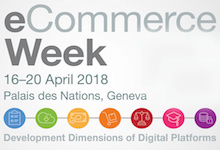Measuring exports of digitally-delivered services
16 Apr 2018 15:00h - 16:30h
Event report
[Read more session reports from the UNCTAD E-Commerce Week 2018]
This session discussed the lessons learned and good practices on measuring exports of services that are digitally-delivered. The moderator, Mr Alexandre Barbosa (Head, Center of Studies for Information and Communications Technologies (CETIC.br)) introduced the topic by highlighting the increased availability of information and communications technologies (ICTs) and the growth of international trade in services globally. Despite attempts by many institutions to make more indicators available on the topic, most countries still face a major gap in the production and collection of data related to ICT-enabled services. A new approach to measuring exports of services delivered over ICT networks has recently been introduced by the United Nations Conference on Trade and Development (UNCTAD) and pilot tested by the Central Bank of Costa Rica, the Directorate General of Commercial Intelligence and Statistics of the Ministry of Commerce of India, as well as the Thai Electronic Transactions Development Agency.
Ms Diana Korka (Economic Affairs Officer, ICT Policy Section, UNCTAD) clarified the definitions used in the survey instrument applied in three pilot countries. Potential ICT-enabled services/digitally-deliverable services refer to outputs that can be delivered remotely over ICT networks (excluding transport services or on-site and in-person services). This needs to be further delineated from actual ICT-enabled serviced, which are digitally-delivered. The expected outcome of the pilot survey was to obtain information on the categories of services delivered over ICT networks, including aspects related to foreign ownership and total turnover. The next steps in the work of UNCTAD include the delivery of a detailed report on lessons learned from pilot survey implementation (April-May 2018) and exploring ways to scale up the study to collect data in more (developing) countries.
Mr Rigoberto Torres Mora (Chief of International Accounts, Macroeconomic Statistics Department, Central Bank of Costa Rica) presented the main results of the pilot survey in his country. In recent years, ICT-enabled services have increased their importance in Costa Rica. Total exports represent 33.2% of the GDP with 5.8% of the GDP coming from ICT-enabled services. The main modes of supply are cross-border, with a concentration in managing, administration and back office services, followed by computers and engineering, and research. A total of 185 enterprises responded to the survey, of which the large majority operated in ICT-enabled services (104), commerce and manufacturing. According to the findings, the capital comes primarily from the US, Europe, and Panama, whereas the regions of destination for exports of digitally-enabled services are US, Europe, and Central America. The gender distribution for ICT-enabled services (34% female, 66% male) is similar to the gender distribution at the national level, Torres Mora concluded. A second measurement of exports over ICT platforms in the country will start in May 2018.
Dr Amitava Saha (Director in-charge of Services Trade Statistics Division, Directorate General of Commercial Intelligence and Statistics, Ministry of Ministry of Commerce and Industry, India) outlined the national experience in conducting the survey and contextualising the findings. Overall, there was need for disaggregated data in India on service trade statistics by partner countries and mode of delivery that this survey helped reduce. India considered 10 categories of ICT-enabled services, including a separate treatment for insurance via an adjusted survey. The data was collected between April 2016 and March 2017 using simple random sampling without replacement. The findings revealed that the total exports of potential ICT-enabled services reach 193 billion $USD with the highest percentages in (1) computer services (including computer software), (2) management, administration and back office services, (3) engineering, related services and R&D. Enterprises with size 250+ contribute around 95% of the ICT-enabled services, with top destination countries including the US, UK and European states. The gender distribution remains similar to that of the respective sector under consideration.
Providing an American perspective on the topic, Ms Jessica R. Nicholson (Senior Economist, Bureau of Economic Analysis, USA) explained that remotely-delivered services represent a new area for data collection in the work of her office, whereas estimates of ICT-enabled trade and modes of supply can be computed based on existent data. Looking at data from 2016, her analysis revealed that the main trading blocks for digitally-enabled services are Europe, Asia-Pacific, and Latin America. Currently, efforts are underway to develop exploratory estimates on modes of supply (ranking by mode of services supplied and received by the US), as well as adequate definitions of digital economy, including digitally-enabled infrastructure, e-commerce and digital media. The digital economy represented 6.5% (1,209.2 billion $ USD) of the total GDP in 2016, growing at an annual rate of 5.6 %. The next step is to start measuring the contribution of digital platforms to the GDP, as well as refining the e-commerce indicators, planned for the near future.
Mr Thierry Coulet (Consultant, UNCTAD) provided additional information about the rationale for the survey and discussed the three pilot surveys comparatively. After explaining the methodology of the study, he made three recommendations for future iterations of the survey: (1) to extend the survey to other developing countries; (2) to address specific cases such as insurance and financial services; (3) to widen the approach and to analyse the role of ICTs in the development of services exports through digitally-ordered transactions, digitally-facilitated transactions, and digitally-delivered transactions.
By Roxana Radu
Related topics
Related event

